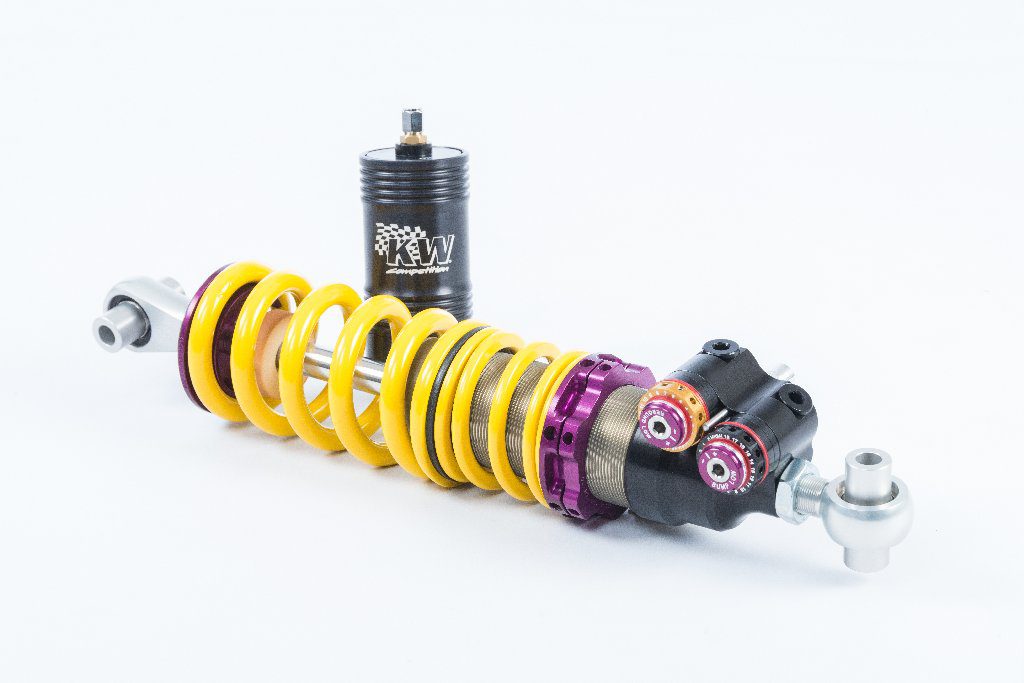KW Solid Piston Technology briefly explained: A short overview of KW GT3 suspensions
The most important rule in the world of motorsports: make sure that the competitors keep their distance! This is only possible with constant development and sustainability.

Sustainability pays off, as well in the world of motorsports. Like a few aftermarket and motorsport operators, we have always put our customers’ requirements and desires at the forefront of everything we do. Every single day. Always in focus: flexibly producing the perfect suspension for every demand.

Over the past six years, KW invested extensively at its headquarters in Fichtenberg. This created further production capacities, numerous automation processes and a modern logistics centre – you can find out more about this on their blog.

But they wouldn’t be KW automotive if nothing more happened in the meantime. This time, they use the recent overall victory of their long-time KW Competition partner Manthey-Racing at the Nürburgring 24h race and numerous class victories of our motorsport customers at the 24h classic on the Nordschleife as an opportunity to highlight KW's motorsport activities – because, according to Bill Clinton’s Spin Doctor James Carville, “It’s the Technology, stupid!”
For this reason, we rely on KW Solid Piston Technology

The BMW M4 GT3 race car available in 2022 will also be supplied with KW Solid Piston racing dampers.
As the demand for race cars concerning aerodynamics in the GT3 customer sports program keeps increasing, the aero loads on vehicles such as the Porsche 911 GT3 R become stronger and stronger. An additional factor is higher speeds – not only on the straight but also in corners.

Therefore, the components of a race car, and in particular the racing dampers, can get overburdened. Accordingly, modern vibration dampers have to be capable of far more than the state-of-the-art dampers of about ten years ago.

respectthebumps – the bumps at the Sebring 12h race are notorious.
In addition to aerodynamics, tyres, track layouts and track topography, as well as individual characteristics of various racetracks – circuits with sometimes bad track surfaces such as the “#respectthebumps” Sebring International Raceway in the USA – influence the performance of a suspension.

Whether Caracciola carousel, Flugplatz, or Fuchsroehre – the Green Hell also requires top performance from the damper.
KW Solid Piston dampers from the KW Competition program can perform much better on short suspension travels because of their design. This is one of the reasons why KW also adapt the Solid Piston Technology to its road applications such as the KW coilover Variant 5.

KW Variant 5 front axle damper for Corvette C8 Stingray
Advantage: KW Solid Piston Technology

KW Competition racing dampers based on the Solid Piston principle from 2017
Since the presentation of the KW Solid Piston racing damper technology with offsetable valves at the Professional Motorsport World Expo in Cologne in November 2017, KW significantly expanded its KW Competition racing applications using this technology.

The KW Competition dampers, which are constructed according to the Solid Piston principle, enable a wide force range from, for example, 1500 N to 12000 N with KW's modular and flow-optimized valve technology.

SCG 004 prototype race car at the Nürburgring 24h race
Modern GT3s benefit from the KW Solid Piston Technology as much as any other race cars, whether circuit, hill climb, single-seaters in SAE Student (Formula Student) and prototype race cars in the sports car class (LMP).
Anyone who watched the 49th ADAC Total 24h Race Nürburgring 2021 could clearly see the precise and highly frequent function of the dampers with their low valve lift while the Manthey-Racing Porsche 911 GT3 R drove over the grass. Despite Kévin Estre’s off-road evasive maneuvers, the 911 remained controllable.

Cross-section through a KW Competition 5A SPEC II racing damper with Solid Piston design
In comparison to differently constructed racing dampers, KW Solid Piston Technology does not use an overflowing working piston. This way, they achieve cavitation-free operation at low vapour pressure.

KW Competition 4A damper in the Rowe Racing BMW M6 GT3 at the Nürburgring 24h race.
Another argument in favour of our racing applications with KW Solid Piston is the fact that the valves used in standard production can be offset for compression and rebound forces


Thus, the valve cross-section openings can be adapted to KW customers’ purposes in low-speed, and KW can individually adjust the valve spring preload in high-speed. A more flexible characteristic curve design makes it possible to set the responsiveness of the dampers more variably.

Distinct KW Solid Piston racing dampers
KW Solid Piston dampers have long been available in different variants such as non-adjustable cup dampers, 2-way adjustable dampers, 4-way adjustable dampers and 5-way adjustable dampers.

MacPherson strut with 4-way adjustable damper in “Upside-Down design” for wheel-controlling front axle geometry
Depending on the specific demands, they manufacture KW Solid Piston shock absorbers with or without an external piggyback (reservoir), which is either connected through a tube or directly to the damper housing. Moreover, there are already variants with internal reservoirs made by KW.

Solid Piston 5A SPEC I racing damper with an internal reservoir and blow-off valve adjustment on the piston rod
KW consistently refined its 5-way adjustable Solid Piston racing damper introduced in 2019 – internally referred to as the Spec I – just like the 4-way adjustable Solid Piston shock absorber. Obviously, KW has never been known for resting on its laurels.
“The Über-Dämpfer: KW Competition 5A Spec II damper”
-


KW TTSP35 5A “SPEC II” configured with linear spring and preload spring -


On various race cars, the “SPEC II” with its lug–lug fastening is installed like this
While it will still take some time before the new KW Competition 5A Spec II damper is also used in customer racing in the BMW M4 GT3, which will be available in 2022, the “Spec II” has already demonstrated its excellent performance in the Porsche 911 GT3 R on the Nürburgring Nordschleife several times.


After “Grello” aka the yellow-green Manthey-Racing Porsche 911 GT3 R convinced with the Spec II in the Nürburgring Endurance Series and the ADAC Total 24h-Race, other Porsche teams such as Falken Motorsport are now switching to the new “KW TTSP35 5A Spec II”.

KW construct the 5-way adjustable Spec II with internal or external reservoirs. In contrast to Spec I, we integrated the blow-off valve directly on the damper housing with the adjustable high-speed and low-speed valves for the compression and rebound forces.

Besides, we enhanced one or the other detail on the damper and valves in the 4A and 5A Spec II to provide an even wider and freer set of characteristic curves. On race cars with pushrod, double arm, and multi-arm axle geometry, KW can extend the damper housing by screwing in shims.

Therefore, KW can offer the possibility of additionally adapting the damper by altering the vehicle height when the axle geometry is modified.
The perfect setup for every demand!

KW motorsport customers appreciate them for their numerous engineering and general services in Fichtenberg. For example, KW motorsport engineers and technicians are on-site at racing events, along with their service trucks for KW customer teams as well as for others. But this represents only a small part of KW service activities.

In their segment, KW is the only aftermarket suspension manufacturer worldwide that disposes of a vehicle dynamic test bench. On one hand, KW uses this to test and develop more than 26,000 suspension applications. On the other hand, numerous racing teams, small-scale manufacturers, motorsport customers and many other KW engineering partners book KW's vehicle dynamic test rig.

As any automotive enthusiast who is interested in technology knows, an automobile suspension consists of all the components that serve to connect the body to the road. Preparing a suspension setup on a race car is always about finding the maximum grip.
-

Spec I 4A rear axle damper with inserted “shims extension” -

Spec I 4A front axle damper: The “shims extension” can be seen well
In addition to tyre compounds and various aerodynamic packages, suspension dampers and elastomer spring elements are among the most important adjusting screws to increase the grip level of the tires, for instance. To enable objective and reproducible testing under laboratory conditions, KW successfully use a vehicle dynamic test bench (7-Post-Rig).
With the KW vehicle dynamic test bench, motorsport teams can analyze various setups in terms of the interaction of different suspension components and come up with distinct setups in a very short time.

Simply explained, the test bench allows us to examine the different influences of spring rates and damping on the vibration behaviour of the vehicle. Various measurement and simulation methods such as 4-Post-Sweeps, 4-Post-Track-Replays, 7-Post-Sweeps, and 7-Post-Track-Replays are available for this purpose.

In the 4-Post mode, the vertical acceleration of the four large stamps makes the vehicle vibrate. The wheels, which are wired with sensors, are on the stamps.

In the stroke sine wave, the wagon passes through a frequency band from one hertz to 20 hertz when the speed of the stamps remains constant (75 mm/s, 150 mm/s, 200 mm /s or 250 mm/s). Such a measurement takes only a little more than one minute (64 seconds).

With this data, our motorsport engineers can observe exactly what happens to the wheel suspension on the race car when it rolls over a bump or curb (kerb).

At the same time, we analyze how quickly this force impulse is dampened and compensated by the suspension. It also helps us to quickly see how the tyres affect the setup at different air pressures, or with which suspension setting a rain tire works better.
Things get really interesting when a so-called track replay is done. In this case, we can give an account of entire circuits and various track sections via the driving dynamic test bench. In the 7-Post mode, we can also simulate aero loads with the test bench.

At the KW test centre, a large part of the optimizations can be carried out directly on-site within one day. To do so, the race car must not even be driven a single meter on the racetrack. By the way, one day on the vehicle dynamic test bench roughly corresponds to three to four days of testing on a racetrack with a GT3 race car.

KW motorsport customers use all the analysis and optimizations on the vehicle dynamic test bench as a basis for their tests and set-up drives, or at short notice to test new set-ups for an upcoming endurance race.
Images KW, Gruppe C Photography, Jürgen Tap, Words C. Schmidt
.png)

